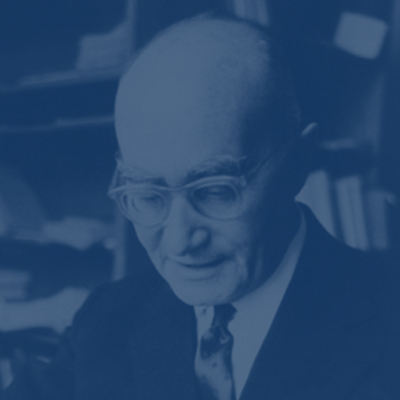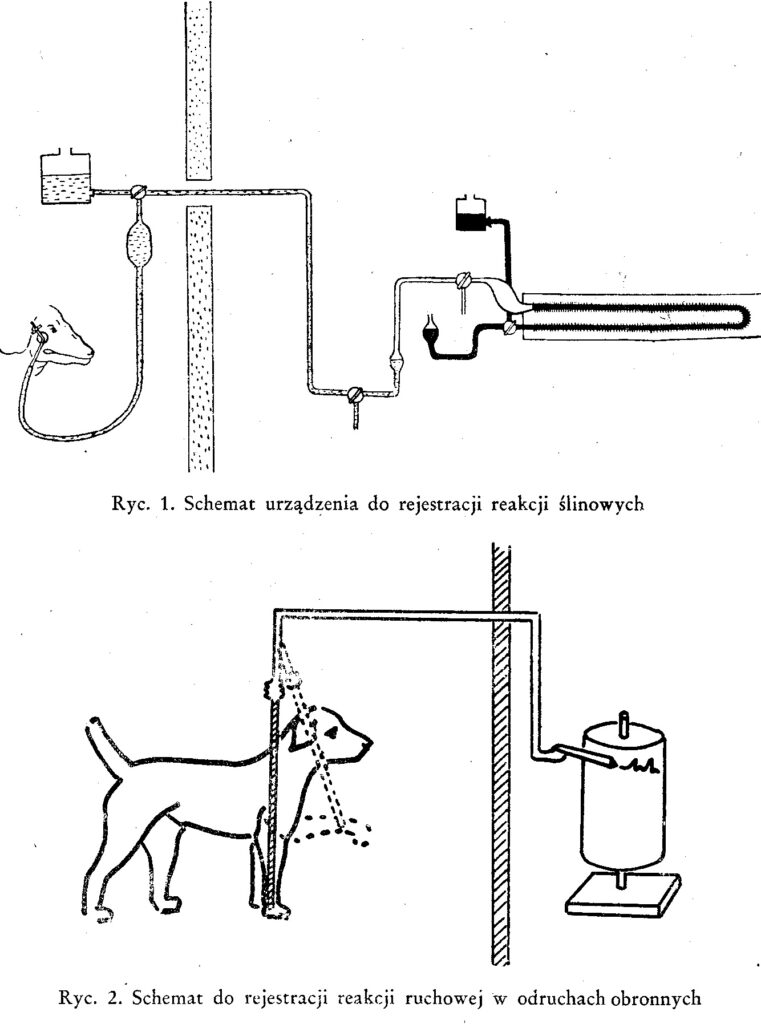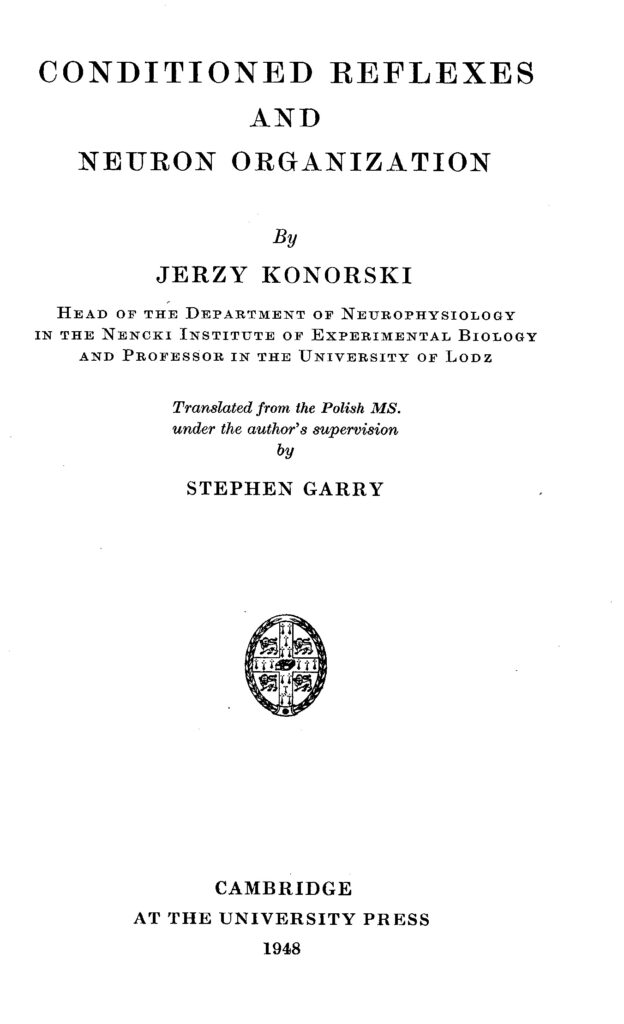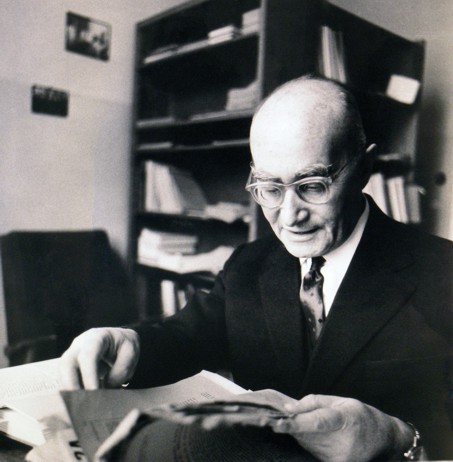Professor Jerzy Konorski, the founder of the Polish School of Brain Physiology, was born on December 1, 1903, in Łódź, an industrial Polish city, which at that time belonged to Tsarist Russia. His father was a lawyer. In 1910 he began his education in a Polish gymnasium, which was a combination of elementary and high school. At that time, it was considered utterly unpatriotic to send a child to Russian schools, which were under social boycott. He graduated from the gymnasium in 1921, after Poland had attained independence. Already at that time he wished to become a scientist, although his interests were broad and undefined. Because of this lack of determination on specialization he wanted to choose, he began studying mathematics at the Warsaw State University, then moved to psychology. However, he became completely bored and disappointed, since he found no answers on how brain works either in the classical textbooks of psychology or in the courses of human psychology taught at the University. He finally decided to study medicine but it was another series of disappointments. The study required learning by heart a great number of data of no use to him, and it was frustrating.

Rescue from this troublesome and seemingly hopeless situation came quite unexpectedly. It happened in 1927 during his third year of medical studies. He was then on very friendly terms with a colleague, Stefan Miller. Both of them came quite incidentally across two Pavlov’s books on conditioned reflexes, which had just been published in Russian (Pavlov was a Nobel prize laureate). They immediately realized that this was exactly the field of science they were looking for and became entirely involved in studying Pavlov. They decided to incorporate the experiments involving motor behavior into the general scheme of Pavlovian experimentation in such a way that a given neutral stimulus, e.g. the sound of a metronome, would be combined with a given movement, which would be reinforced by food, and then punished by a noxious agent. Since they considered that such conditioned reflexes differed essentially from those of Pavlov, they decided to call them conditioned reflexes of the second type, whereas the Pavlovian conditioned reflexes they denoted as the first type. They began to look for a laboratory where the experiments could be performed. After several unsuccessful inquiries, Professor Jacob Segal, the chair of the Department of Psychology at the Free Polish University, became interested in their ideas and offered them a small room in his department on February 1, 1928.
Using a home-made equipment they performed a number of experiments on one dog named Bobek which allowed them to establish the type II conditioned reflex and to discover a phenomenon now called “avoidance conditioning.” Results of these experiments were presented to the Warsaw Branch of the French Biological Society in Paris, and then published in Comptes Rendus de la Societe de Biologic et de ses Filiales. They received also a letter with congratulations from Pavlov.
When Konorski’s and Miller’s position was much strengthened, they were allowed to continue their work in the laboratory of Professor Czubalski, who was the head of the Chair of Human Physiology at the Faculty of Medicine of the Warsaw University.
After graduation in medicine in 1929 they were employed by Professor Luniewski at the State Psychiatric Hospital in Pruszkow, where they were allowed to build a laboratory of conditioned reflexes. However, the work in this field did not progress, because they were at that time so much concerned with psychiatry. During their stay in Pruszków, a monograph written in Polish was published, in which they presented all their experimental results on the type II conditioned reflexes. They claimed that these reflexes represent the physiological model of voluntary behavior and considered them to possess quite a different mechanism from the Pavlovian (type I) conditioned reflexes.
In the meantime, in one of his letters, Pavlov proposed Konorski and Miller to come to Leningrad to discuss their results and perhaps perform some work. At that time there was a true “iron curtain” between Poland and Soviet Russia, and contacts between the two countries were practically nonexistent. However, thanks to the help of Pavlov, whose authority in both Russia and Poland was very high, they were easily granted the Soviet visa in 1931.
After coming to Leningrad, Konorski was accepted by Pavlov as a member of his laboratory and thus became one of “Pavlov’s pupils”. He stayed there till 1933 (Miller had to return to Poland after a few months). At that time Pavlov was 82 years old but his excellent memory was famous and was the “spiritus movens” of the work going on in his laboratories. The routine of the experimental procedure was very rigid and essentially the same in the whole laboratory which resulted in amazingly constant and stable responses to each of the conditioned stimuli and amazingly stereotyped behavior of the animals during the sessions.

The main achievement during Konorski’s stay in Leningrad was confirmation under more rigorous experimental conditions of the results he had obtained in Warsaw, that positive type I (classical) alimentary conditioned stimuli completely inhibited type II response, whereas negative type I conditioned stimuli might even increase this response. Moreover, by applying as an unconditioned stimulus, the introduction of acid into the dog’s mouth, they established avoidance conditioned reflexes and could study the relations between motor and salivary responses. All these results were published in 1936 (Konorski and Miller, 1936). Pavlov highly appreciated the importance of Polish scientists’ contribution to the field of conditioned reflexes but strongly opposed their thesis claiming the existence of two types of conditioning and failed to see any difference between them. However, quite independently of Konorski’s and Miller’s work, in the United States, type II conditioned reflexes were also discovered and called “instrumental” or “operant” responses.
After arrival in Warsaw in June 1933, Konorski was invited by Professor Jan Dembowski, one of the leading biologists in Poland, to give a lecture concerning his work with Pavlov. Among the audience there was a young woman, Dr. Liliana Lubinska, who had returned six months earlier from Paris, where she had studied biology at the Sorbonne, obtained a doctoral degree there, and was a pupil of a famous French neurophysiologist, Louis Lapicque. A few days later, Lubinska brought Miller and Konorski to Professor Kazimierz Białaszewicz, the head of the Department of Physiology at the Nencki Institute of Experimental Biology. He gave his consent to establish a small laboratory of conditioned reflexes in his department. Dr. Lubinska became not only a valuable Konorski’s collaborator but his wife, as well.
After returning from Leningrad, Konorski had learned more about Sherringtonian neurophysiology, and realized that his views were completely incompatible with those of Pavlov. According to Pavlov, excitatory and inhibitory processes were assumed to arise in particular “points” of the cortex as the effects of excitatory and inhibitory conditioned stimuli. Both these processes were to spread in a wavelike manner over the cortex, affecting larger or smaller areas, and mutually restricted each other. The Sherringtonian idea concerning the functioning of the nervous processes was entirely different. Sherrington has shown that each neuron is a convergence point of both excitatory and inhibitory influences determining the intensity of its discharges which, in turn, are conveyed by axons to other neurons. Konorski already had no doubt that it was Pavlov’s theory that should be rejected.
Besides this theoretical work undertaken during that period, he was intensely involved in experimental work on conditioned reflexes. Unfortunately, most of the experimental material obtained before the war was lost. Perhaps the most important published work of this period was that concerned with the problem of interrelations between alimentary and defensive type II conditioned reflexes, which appeared in 1939. Moreover, he and Miller became involved in an interesting discussion with Skinner who performed experiments based on his now well-known experimental procedure (the “Skinner box”).
On September 1, 1939, Germany invaded Poland. After a three-week siege of Warsaw, during which the Nencki Institute was bombarded by artillery, the city surrendered. Poland was defeated, which led to a complete change in Konorski’s life. In October or November he received information from England that a friend of his in Cambridge had transferred a sum of money to Riga (the capital of Latvia) in order to help him to come to London via Scandinavia. Therefore, he and his wife decided to go east in order to reach Riga. However, a few days after their arrival in Białystok (a Polish city which was then in the hands of the Soviet Army) the frontier between Russia and Latvia was closed and there was no possibility of crossing it. Then he got in touch with his colleagues at Pavlov’s laboratory in Leningrad, and they lent him a helping hand. He obtained a formal invitation to come to Leningrad and proposal to become the head of the Department of Physiology in the Subtropical Biological Station in Sukhumi, Caucasus, the famous Primate Research Center. In June 1940, Konorski decided to continue his work on type II conditioned reflexes, now utilizing monkeys instead of dogs. Furthermore, he started to work in the field, which might be of some value for practical war medicine, i.e. in traumatic neuroses and nerve regeneration. When the German Army was quite near Sukhumi the Institute was evacuated to Tbilisi, the capital of Georgia, where Konorski stayed for a number of months. In the spring of 1945 he decided to end his stay in Sukhumi, returned as quickly as possible to Poland and resumed work at the Nencki Institute.
In 1945 Warsaw was in ruins. Therefore, Konorski and his wife together with Dr. Niemierko and his wife, their old friends who had worked in the Nencki Institute before the war, decided to settle the Institute in Łódź. Their decision was immediately accepted by the Minister of Education, Mr. Wycech, who signed the appropriate certificates. Among other motives which determined their decision with regard to localization of the Institute in Łodź was that the new University was being organized there and its President, Professor Kotarbinski a famous philosopher, offered the chairs of animal physiology and neurophysiology to Professor Niemierko and to Konorski, respectively. In 1947 the Institute was ready to begin experimental work. It consisted of three main departments: Department of Biology, Department of Biochemistry and Department of Neurophysiology, the latter headed by Konorski. Professor Dembowski became the Director of the Institute.
In Łodź, Konorski decided to write a book that would present the whole field of conditioned reflexes “translated” into the language of modern neurophysiology in Polish which was then translated to English by Mr. Stephen Garry. The book entitled: Conditioned Reflexes and Neuron Organization was published in 1948 by the Cambridge University Press.
During that time perhaps the most important Konorski’s accomplishment was related to a radical change in his views on internal inhibition, caused by completely unexpected results of his experiments. His former concept asserted that internal inhibition arising in the course of extinction of differentiation of conditioned reflexes was a synaptic process, and that inhibitory conditioned reflexes were due to the inhibitory synapses being formed between the center of the conditioned stimulus and the center of the unconditioned stimulus. These inhibitory synapses were supposed to grow side by side with excitatory synapses, so the inhibitory reflex was considered to be in essence an excitatory-inhibitory reflex. It was further assumed that inhibitory connections developed because of the prior existence of excitatory connections; accordingly, the strength of the inhibitory conditioned reflex was thought to be positively correlated with the strength of the excitatory reflex from which it was formed. However, the results of his new experiments were just the reverse: it turned out that the stronger the original excitatory reflex to a given conditioned stimulus was, the weaker the inhibitory reflex was produced by that stimulus when it was not reinforced.

The second important discovery was that there are double connections linking the “center” of the conditioned stimulus with the “center” of the instrumental motor act. On the one hand, there are indirect connections running through the center of the unconditioned stimulus. On the other hand, there are direct connections linking the two centers. In this period a new field of investigation was also opened up in Konorski’s laboratory, namely, he introduced a technique of ablation of the cerebral cortex. Using this technique Konorski and his collaborators discovered that after prefrontal lesions, the inhibitory conditioned reflexes were strongly disinhibited while the excitatory reflexes remained unchanged. Ablation of the motor cortex, in general, did impair to a greater or lesser degree the performance of the movement (instrumental reaction), but failed to abolish the movement as a behavioral act. In plain language, the animal knew what it had to do, in spite of the fact that the execution of the movement was deficient.
In 1955/56, two years after Stalin’s death, the “thaw” began, when Khrushchev came into power in the USSR and dissociated himself sharply from the Stalinist period, denouncing it somewhat euphemistically as “the cult of personality.” This had huge political, cultural and scientific consequences in Poland. In neurobiology, the pseudo-Pavlovian indoctrination vanished completely, and Konorski no longer was a revisionist and a servant of capitalism. The sign of this radical change of attitude came when Professor Dembowski, the President of the Polish Academy of Sciences, charged him with the task of organizing a symposium on brain and behavior, of which he was to be the main speaker. A big lecture hall at the Palace of Culture was fully attended by an audience which greeted him with an enthusiastic ovation. He was also elected a member of the Polish Academy of Sciences. The second big change which occurred in 1955 laid in the fact that in that year the Nencki Institute was relocated from Łódź to Warsaw, where a new special building had been erected. Konorski planned and accepted every detail of his Department of Neurophysiology and moved to Warsaw.
In 1957 Konorski was sent by the Polish Academy of Sciences for a three-month visit to the United States to become acquainted with scientific centers concerned with brain research. Robert (Bob) Livingston (Director of Basic Research on Neurological Sciences and Psychiatry, National Institutes of Health) sponsored his visit and organized it in an excellent way. Konorski visited all the important centers concerned with physiological psychology in Bethesda, New York, New Haven, Los Angeles, Stanford, Berkeley and others. He encountered a most friendly reception everywhere and regarding his scientific discussions, he met not adversaries but scientific friends. This first Konorski’s visit to America had very great significance for the further development of scientific work of his team. Owing to his connections with American scientists, almost every member of his Warsaw laboratory was able to visit the United States, which significantly broadened their scientific horizons. Consequently, their work became much better known by American scientists than it was before. Owing to Konorski’s frequent visits to the United States and to the visits of many American students of brain research to Warsaw, he became increasingly popular in the United States. People realized that Stefan Miller and Jerzy Konorski were the first investigators who introduced instrumental responses into conditioning experiments. Perhaps this is the main reason why in 1965 he was elected a foreign associate of the National Academy of Sciences.
The new political period, which began in 1956 enabled Polish scientists to establish relations not only with the United States but also with most countries of Western Europe and with scientists of the Eastern countries. In the previous period, these relations had been practically nonexistent, because of their boycott of Konorski. Now the attitude of Soviet scientists toward him changed almost overnight and became friendly. As a result of this change of atmosphere, three laboratories engaged in studying the physiology of the central nervous system: the Institute of Higher Nervous Activity and Neurophysiology of the Soviet Academy of Sciences, the Institute of Physiology of the Czechoslovak Academy of Sciences, and the Konorski’s laboratory organized a common symposium, which was held in Poland in 1959. This symposium was a great success, both scientifically and socially. Friendship between the laboratories became stable, and the participating institutions held similar symposia thereafter every three or four years.
Since the relocation of the Institute from Łódź to Warsaw, its scientific facilities have grown immensely. In the new building in Warsaw, there were excellent soundproof conditioned reflex chambers for dogs and high-level operation rooms for neurosurgery. The prewar journal published by the Nencki Institute, Acta Biologiae Experimentalis was taken over by the Department of Neurophysiology and has been devoted to studies on the brain and behavior. The journal has been published in English and its title has been changed to Acta Neurobiologiae Experimentalis. Konorski became the Editor-in-Chief of this journal.

The important discovery of that time in the studies concerning the mechanisms of instrumental conditioning, was made by Górska and Jankowska (1961). They found that deafferentation of the limb involved in a previously trained response did not abolish that response; this means that the proprioceptive feedback of the limb performing a given acquired movement is not indispensable for the execution of that movement. This result clearly contradicted the theory of type II conditioning, originally advanced by Miller and Konorski, according to which this type of conditioning was fully dependent on the proprioceptive feedback.
Another important result was obtained by Tarnecki (1962), who showed that a movement of the hind leg elicited by stimulation of the motor cortex, followed by food reinforcement, could not be transformed into an instrumental response, whereas a movement elicited by the sensory cortex could. The analysis of this fact, together with some other data, has led to the conclusion that only movements elicited by the afferent input (including stimulation of the sensory cortex) can be instrumentally conditioned.
Finally, the experiments of Ellison and Konorski (1965) have shown that the alimentary instrumental response (or rather its kinesthesis) does not necessarily elicit the salivary response. Moreover, studies by Wyrwicka and Fonberg allowed Konorski to distinguish two parallel systems determining the animal’s behavior: the thalamo-cortical system on the one hand and the hypothalamo-amygdalar system on the other. Additionally, the most daring idea advanced by Sołtysik, claimed that consummatory food conditioned responses (mediated by the thalamocortical system) inhibited instrumental responses produced by the hunger drive (mediated by the hypothalamo-amygdalar system).
The other line of research concerned the study of the functional organization of various regions of the cerebral cortex. The most important task consisted in the analysis of the effects of partial prefrontal lesions upon animal behavior. Furthermore, studies on the effects of focal cerebral lesions on the behavior of patients were undertaken with Professor Lucjan Stępień and his group in the neurosurgical hospital which concentrated on the problem of speech disorders and the pathophysiology of various forms of aphasia.
In 1963 Konorski was proposed by the University of Chicago Press to write a monograph in his field. Konorski worked on the book entitled: Integrative Activity of the Brain for three and a half years, the book was completed in the summer of 1966 and published in 1967. This book presented a new synthesis of the integrative activity of the brain based on new facts and new concepts. The Author considered it to be good and important. The Professor Konorski career culminated in 1968 when he became a Director of the Nencki Institute.
Professor Konorski died on September 14, 1973. He was buried at the Powązki Cemetery in Warsaw.
Biogram was prepared by Krystyna Ossowska on the basis of:

